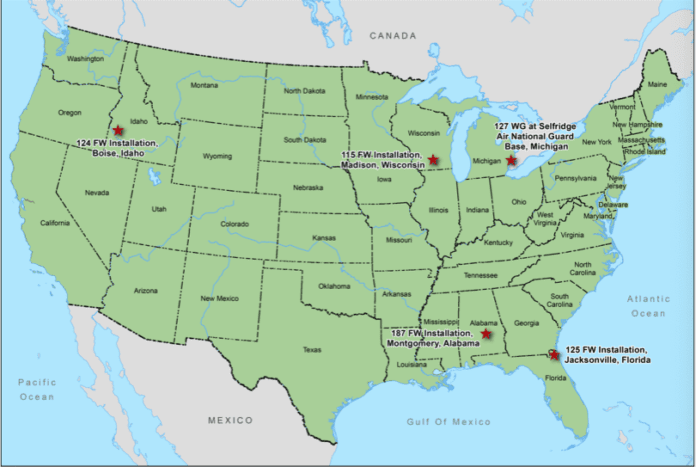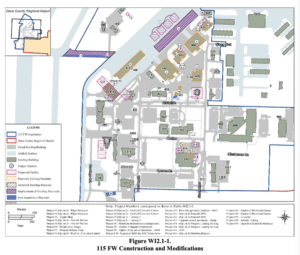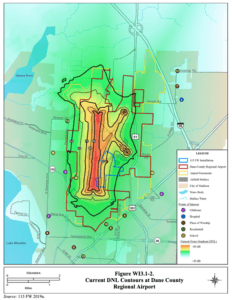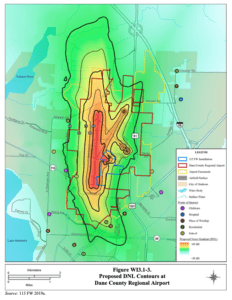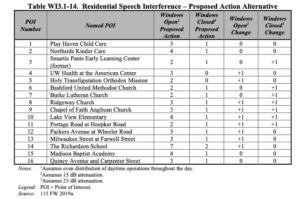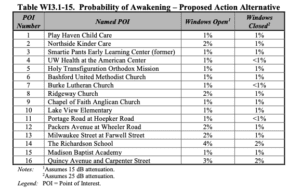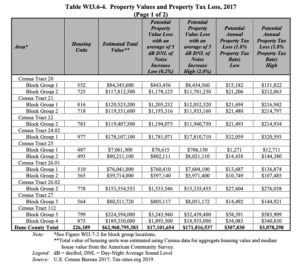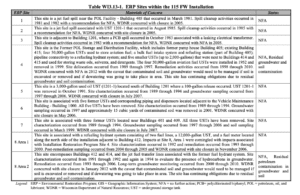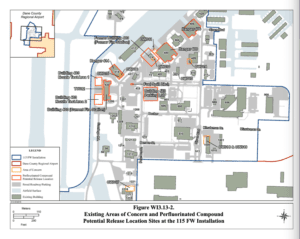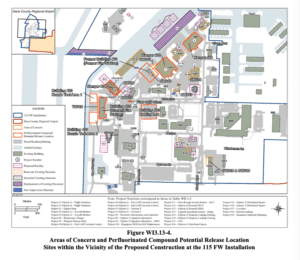This is a quick look at the final Environmental Impact Statement released today by the Air National Guard. It contains their analysis of how they will impact our community or 4 others.
As far as I can tell, not much has changed, Madison is still the preferred alternative. Here’s how they responded to our questions and comments.
WHERE TO FIND DOCUMENTS
Here’s the Air National Guard (ANG) Environmental Impact Statement (EIS) page where the Final EIS is. The information in this post is only from the final EIS summary and some brief points of interest from the section specific to Madison. There are countless (unless you want to count them) number of pages to review. Here’s what I could glean in a couple of hours.
DIFFERENCES IN COMPARISON OF THE 5 OPTIONS
This information is in the charts that start on page ES-16 of the summary
ENVIRONMENTAL JUSTICE AND THE PROTECTION OF CHILDREN
Here is looks like Boise Idaho and Jacksonville Florida are better options – then Michigan.
115 FW – Madison, Wisconsin
There would be significant disproportionate impacts to low-income and minority populations as well as children. The increase in noise exposure to the south of the airport would disproportionately impact low-income areas and the increase in noise exposure to the east of the airport would disproportionately impact a low-income minority population. In addition, the Proposed Action could disproportionately impact children.
124 FW – Boise, Idaho
impacts to environmental justice associated with the Proposed Action are not considered to be significant.
125 FW – Jacksonville, Florida
impacts to environmental justice associated with the Proposed Action are not considered to be significant.
127 WG – Selfridge Air Nation Base, Michigan
There would be no significant disproportionate impacts to low-income or minority populations.
Some schools would be affected by increased noise levels, with associated adverse impacts of interrupted speech and hindrance of learning. In addition, there are six impacted block groups that have higher proportions of children than the surrounding area and there are four impacted block groups that have lower proportions of children than the surrounding area. Therefore, the Proposed Action would significantly disproportionately impact children.
187 FW – Montgomery, Alabama
There would be significant disproportionate impacts to low-income and minority populations as well as children. Since all of the block groups surrounding the airport and under the noise contours are considered environmental justice communities and there would be increased impacts, there would be disproportionate impacts on low-income and minority populations under the Proposed Action. Three of the five block groups with noise levels above 65 dB DNL under the Proposed Action have a higher proportion of children than Montgomery County as a whole. Together with the increased impacts at Martin Luther King Elementary School, there could be an adverse and disproportionate impact to children, to include low-income and minority children under the Proposed Action.
HAZARDOUS MATERIALS AND WASTES, AND OTHER CONTAMINANTS
115 FW – Madison, Wisconsin
Impacts relative to hazardous materials, wastes, and other contaminants would not be significant.
There would not be an increased risk of hazardous waste releases or exposure from this alternative.
Omission of hydrazine, cadmium fasteners, chrome plating, copper- beryllium bushings, and the use of a non- chromium primer.
Increase in airfield operations would increase the throughput of petroleum substances (e.g., fuels, oils) used during F-35A operations.
Six ERP sites (Site 1, Site 4, Site 5, Site 7, Site 8 Area 1, and Site 8 Area 2) overlap with the proposed construction under this alternative. All six ERP sites are closed. Three perfluorinated compound PRLs including Hangar 400, Hangar 406, and Hangar 414 overlap with the proposed construction. As applicable, the 115 FW would coordinate with the WDNR regarding proposed construction near ERP sites. The 115 FW will comply with Air Force Guidance Memorandum (AFGM2019-32-01) AFFF-Related Waste Management Guidance to manage waste streams containing PFOS/PFOA.
124 FW – Boise, Idaho
Impacts relative to hazardous materials, wastes, and other contaminants would not be significant.
There would not be an increased risk of hazardous waste releases or exposure from this alternative.
Omission of cadmium fasteners, chrome plating, copper-beryllium bushings, and the use of a non-chromium primer.
Increase in airfield operations would increase the throughput of petroleum substances (e.g., fuels, oils) used during F-35A operations.
There is a potential of impact from PFOS/PFOA potential release sites Hangar 148, Hangar 1529, Hangar 1530, and Hangar 155 due to potential PFOS/PFOA contamination in soil and groundwater. A construction plan would be created for the proposed renovations at Hangars 148, 1529, 1530, and 155 to minimize direct contact with soil and groundwater. No other ERP sites overlap with the proposed construction under this alternative.
One ERP site (Site 9) overlaps with proposed construction under this alternative. This site has been recommended for NFA with site closure. The 124 FW will comply with Air Force Guidance Memorandum (AFGM2019-32-01) AFFF-Related Waste Management Guidance to manage waste streams containing PFOS/PFOA.
125 FW – Jacksonville, Florida
Impacts relative to hazardous materials, wastes, and other contaminants would not be significant.
There would not be an increased risk of hazardous waste releases or exposure from this alternative.
Omission of cadmium fasteners, chrome plating, copper- beryllium bushings, and the use of a non- chromium primer.
The increase in airfield operations would increase the throughput of petroleum substances (e.g., fuels, oils) used during F-35A operations.
One ERP site, Site 4 OWS at Hush House, overlaps with the proposed construction under this alternative.
There is a potential of impact from PFOS/PFOA potential release sites Hangar 1001, Hangar 1029, Old Fire Station #1, Old Fire Station #2, and Current Fire Station. The 125 FW will comply with Air Force Guidance Memorandum (AFGM2019-32-01) AFFF-Related Waste Management Guidance to manage waste streams containing PFOS/PFOA.
127 WG – Selfridge Air Nation Base, Michigan
Impacts relative to hazardous materials, wastes, and other contaminants would not be significant.
There would not be an increased risk of hazardous waste releases or exposure from this alternative.
Omission of cadmium fasteners, chrome plating, copper- beryllium bushings, and the use of a non- chromium primer.
The increase in airfield operations would increase the throughput of petroleum substances (e.g., fuels, oils) used during F-35A operations. Three ERP/AOC sites (Site 7, Site 21, and TU051) and two PFOS/PFOA sites (#4, and #15) overlap with the proposed construction under this alternative. As applicable, the 127 WG would coordinate with the EGLE1 regarding proposed construction near ERP sites, on Selfridge ANGB. The 127 WG will comply with Air Force Guidance Memorandum (AFGM2019-32-01) AFFF-Related Waste Management Guidance to manage waste streams containing PFOS/PFOA.
187 FW – Montgomery, Alabama
Impacts relative to hazardous materials, wastes, and other contaminants would not be significant.
There would not be an increased risk of hazardous waste releases or exposure from this alternative.
Omission of cadmium fasteners, chrome plating, copper-beryllium bushings, and the use of a non-chromium primer.
Minimal change in airfield operations, therefore no noticeable change in throughput of petroleum substances (e.g., fuels, oils) used during F-35A operations. Two ERP sites and three PFOS/PFOA sites overlap with the proposed construction under this alternative. As applicable, the 187 FW would coordinate with the ADEM, regarding proposed construction near ERP. The 187 FW will comply with Air Force Guidance Memorandum (AFGM2019-32-01) AFFF-Related Waste Management Guidance to manage waste streams containing PFOS/PFOA.
NOISE
Hearing loss in other areas is negligible. In Madison it is “not anticipated”. Number of poople exposed in Madison is 2,215 in 65 db DNL and 292 in 70-75 DNL, the second largest of all the options, only exceeded by Michigan. We have the highest probability of being awakened (2-4%) but Michigan has (<1-5%) See pages ES-17 and 18 for additional informaiton on other locations.
115 FW – Madison, Wisconsin
Based on context and intensity, the change in the noise environment associated with the Proposed Action would be considered significant in the area surrounding the airfield. Changes in DNL results in an additional 1,320 acres within the 65 dB noise contour where compatible land use recommendations are triggered. As a result, the number of households located within the 65 dB DNL contour would increase by 1,019 and the number of people exposed would increase by 2,215. One hundred thirty-two of the households and 292 persons would be located in the 70-75 DNL contour where housing is incompatible absent an exception. Interference with classroom speech would remain the same or increase by one event per hour. Speech interference in residential areas would remain the same or increase by one event per hour. The probability of awakening would remain low at between 2% and 4% of the population with windows open and 1% or less with windows closed. The potential for hearing loss to off- installation personnel is not anticipated.
Impacts to the acoustic environment beneath the SUA would not be significant. The increase in Ldnmr as a result of subsonic operations would be between 1 and 4 dB, with the greatest change (4 dB) beneath the Volk East MOA, and highest Ldnmr of 57dB beneath the Volk South MOA. Increases in CDNL as a result of supersonic flight operations would be between 1 and 2 dBC, with overall CDNL remaining below 50 dBC.
Overall, the Proposed Action would be anticipated to result in significant impacts to the airport noise environment, but have no significant impacts in the SUA.
The USAF does not have authority to expend appropriated funds on facilities that are not under the direct control of the USAF. However, the FAA has a program that addresses noise and compatible land use near airports. Title 14, CFR, Part 150 – Airport Noise Compatibility Planning, the implementing regulations of the Aviation Safety and Noise Abatement Act of 1979, as amended, provides a voluntary process an airport sponsor can use to mitigate significant noise impacts from airport users. It is important to note that the Part 150 program is not a guarantee that sound mitigation or abatement will take place. Eligibility for sound insulation in noise-sensitive land uses through the FAA’s Airport Improvement Program requires that the impacted property is located within a DNL 65 dB or higher noise contour and meet various other criteria in FAA guide documents used for sound mitigation.
124 FW – Boise, Idaho
Based on context and intensity, the change in the noise environment associated with the Proposed Action would be considered significant in the area surrounding the airfield. Changes in DNL results in an additional 446 acres within the 65 dB noise contour where compatible land use recommendations are triggered. As a result, the number of households located within the 65 dB DNL contour would increase by 272 and the number of people exposed would increase by 665. Eighty-three of the households and 199 persons would be located in the 70-75 DNL contour where housing is incompatible absent an exception. Three of the school POIs located within the ROI would experience an increase in the number of events causing speech interference but only Owyhee-Harbor Elementary School would exceed Leq of 65 dB. Speech interference in residential areas would remain the same or increase by one event per hour. The probability of awakening would either remain the same or increase by 1%. The potential for hearing loss to off-installation personnel is negligible
Overall, the Proposed Action would be anticipated to result in significant impacts to the airport noise environment, but have no significant impacts in the SUA.
125 FW – Jacksonville, Florida
Based on context and intensity, the change in the noise environment associated with the Proposed Action would not be considered significant in the area surrounding the airfield. Changes in DNL results in a reduction of 688 acres within the 65 dB noise contour where compatible land use recommendations are triggered. As a result, the number of households located within the 65 dB DNL contour would decrease by 4 and the number of people exposed would decrease by 15. Interference with classroom speech would increase at one school by one event per hour. Speech interference in residential areas would remain the same or increase by one event per hour. The probability of awakening would remain low at less than 1% of the population with windows open and with windows closed. The potential for hearing loss to off- installation personnel is negligible.
Overall, the Proposed Action would not result in significant impacts to the airport noise environment, or in the SUA.
127 WG – Selfridge Air Nation Base, Michigan
Based on context and intensity, the change in the noise environment associated with the Proposed Action would be considered significant in the area surrounding the airfield. Changes in DNL results in an additional 1,073 acres within the 65 dB noise contour where compatible land use recommendations are triggered. As a result, the number of households located within the 65 dB DNL contour would increase by 1,034 and the number of people exposed would increase by 2,902. Forty-five of the households and 130 persons would be located in the 70-75 DNL contour where housing is incompatible absent an exception. Interference with classroom speech would remain the same or increase by one event per hour. Speech interference in residential areas would remain the same or increase by one event per hour. The probability of awakening would change between 0 and 1% in eight areas, remaining at between <1% and 5% of the population with windows open and 1% or less with windows closed. The potential for hearing loss to off- installation personnel is negligible.
Overall, the Proposed Action would be anticipated to result in significant impacts to the airport noise environment, but have no significant in the SUA.
187 FW – Montgomery, Alabama
Based on context and intensity, the change in the noise environment associated with the Proposed Action would be considered significant in the area surrounding the airfield. Changes in DNL results in an additional 1,219 acres within the 65 dB noise contour where compatible land use recommendations are triggered. As a result, the number of households located within the 65 dB DNL contour would increase by 46 and the number of people exposed would increase by 113. Sixteen of the households and 35 persons would be located in the 70-75 DNL contour where housing is incompatible absent an exception. Interference with classroom speech is predicted not to change. Speech interference in residential areas would remain the same or increase by one event per hour. There is no change in the probability of awakenings. The potential for hearing loss to off-installation personnel is negligible.
Overall, the Proposed Action would be anticipated to result in significant impacts to the airport noise environment, but have no significant in the SUA.
LAND USE
115 FW – Madison, Wisconsin
Off-airport area affected by noise levels equal to or greater than 65 dB DNL increases 1,320 acres overall. Approximately 199 additional acres of residential land use would be included in the 65-75 dB DNL noise contour, rendering this acreage potentially incompatible for residential land use, which would be considered a significant impact.
124 FW – Boise, Idaho
Off-airport area affected by noise levels equal to or greater than 65 dB DNL increases approximately 446 acres overall. Approximately 74 additional acres of residential land use would be included in the 65-80 dB DNL noise contour, rendering this acreage potentially incompatible for residential land use, which would be considered a significant impact.
125 FW – Jacksonville, Florida
Off-airport area affected by noise greater than 65 dB DNL would decrease by approximately 688 acres; no residential land use would fall under areas affected by noise greater than 65 dB DNL. Therefore, there would be no significant impacts.
127 WG – Selfridge Air Nation Base, Michigan
Off-airport area affected by noise greater than 65 dB DNL would increase by approximately 1,073 acres overall. Approximately 475 acres of residential land use would be included in the 65- 75 dB DNL noise contour, rendering this acreage potentially incompatible for residential land use, which would be considered a significant impact.
187 FW – Montgomery, Alabama
Off-airport area affected by noise greater than 65 dB DNL would increase by approximately 1,219 acres overall. Approximately 37 additional acres of residential land use would be included in the 65-75 dB DNL noise contour, rendering this acreage potentially incompatible for residential land use, which would be considered a significant impact.
IMPERVIOUS SURFACE
115 FW – Madison, Wisconsin
New construction footprint of up to 4.9 acres and 1.7 acres of new impervious surface.
124 FW – Boise, Idaho
New construction footprint of up to 5.7 acres and 0.6 acre of new impervious surface.
125 FW – Jacksonville, Florida
New construction footprint of up to 10.8 acres and 1.9 acres of new impervious surface
127 WG – Selfridge Air Nation Base, Michigan
New construction footprint of up to 2.4 acres and 1.4 acres of new impervious surface.
187 FW – Montgomery, Alabama
New construction footprint of up to 4.8 acres and 2.9 acres of new impervious surface.
STORMWATER RUN OFF, WETLANDS
All sites say the same thing except Jacksonville impacts wetlands
Construction would be limited to the area of ground disturbance. A site-specific SWPPP would include measures to minimize potential impacts associated with stormwater runoff during construction, including BMPs and standard erosion control measures.
No significant impacts to surface water, groundwater, and floodplains.
Construction activities would have no impact on wetlands.
ECONOMIC IMPACT
Same conclusion for all sites “There would be no significant impacts to socioeconomics.”
115 FW – Madison, Wisconsin
Up to 64 additional military personnel.
Less than 0.1% increase in population of Dane County, which would be a negligible impact.
Construction spending would have short-term benefits for the local economy.
Negligible impact on the housing market in the city of Madison. Overall, the potential lost property value would represent between 0.03 and 0.27 percent of the tax base of Dane County.
124 FW – Boise, Idaho
Up to 85 additional military personnel.
Less than 0.1% increase in the population of Ada County, which would be a negligible impact.
Construction spending would have short-term benefits for the local economy.
Negligible impact on the housing market in the city of Boise.
Overall, the potential lost property value would represent between 0.01 and 0.13 percent of the tax base of Ada County.
125 FW – Jacksonville, Florida
Up to 85 additional military personnel.
Less than 0.1% increase in the population of Duval County, which would be a negligible impact.
Construction spending would have short-term benefits for the local economy.
Negligible impact on the housing market in the city of Jacksonville or Duval County.
Overall, the potential lost property value would represent between less than 0.01 and 0.01 percent of the tax base of Duval County.
127 WG – Selfridge Air Nation Base, Michigan
Up to 85 additional military personnel.
0.9% increase in the population of Harrison Township and less than 0.1% of the population of Macomb County, which would be a negligible impact.
Construction spending would have short-term benefits for the local economy.
Negligible impact on the housing market in Harrison Township and in Macomb County.
Overall, the potential lost property value would represent between 0.04 and 0.38 percent of the tax base of Macomb County.
187 FW – Montgomery, Alabama
Up to 27 additional military personnel.
Less than 0.1% increase in population of Montgomery County, which would be a negligible impact.
Construction spending would have short-term benefits for the local economy.
Negligible impact on the housing market city of Montgomery or Montgomery County.
Overall, the potential lost property value would represent between 0.01 and 0.14 percent of the tax base of Montgomery County.
INCREASE IN MILIARY OPERATIONS
They conclude the same for all the options “There would be no significant impacts to airspace management and use within the local air traffic environment.” Madison would see the largest increase. And that impacts to “civil and commercial aviation traffic … would be negligible.” FAA approval would be needed for increased altitudes in Madison. Additional informaiton is available on pages 20 & 21. Note the conditions Boise Idaho has on supersonic flights.
115 FW – Madison, Wisconsin
There would be a 47% increase in military operations at the airfield (this would drop to 27% once the F-35A adopts the alert mission), 3% increase in total airfield operations.
There would be an approximate 28% increase in time spent within the airspace. The existing agreements in place between the scheduling agencies, and 115 FW would be sufficient to support F-35A flight operations. A new LOA with the FAA would be required to support the need for increased ATCAA altitude.
124 FW – Boise, Idaho
There would be an 18% increase in military operations at the airfield, 1% increase in total airfield operations.
There would be up to an approximate 47% increase in time spent within the airspace.
In accordance with previous agreements, supersonic activity would occur only in the airspace and at altitudes and times currently approved for supersonic flight. Seasonal restrictions for supersonic flight below 15,000 feet AGL along the Owyhee River system would not change. Flight restrictions over the boundaries of the Duck Valley Reservation would remain in place. The addition of F-35A supersonic events occurring above 10,000 feet AGL and below 30,000 feet MSL in the Owyhee North and Jarbidge North MOAs/ATCAAs could result in an exceedance of the number of supersonic operations (730 events) approved in the 2016 supersonic waiver (366th Operations Support Squadron/OSO 2016).
125 FW – Jacksonville, Florida
There would be a 28% increase in military operations at the airfield, 1% increase in total airfield operations.
There would be an approximate 28% increase in time spent within the airspace.
127 WG – Selfridge Air Nation Base, Michigan
There would be a 32% increase in 127 WG operations; 8% increase in total airfield operations.
There would be up to an approximate 54% increase in time spent within the airspace.
187 FW – Montgomery, Alabama
There would be a 1% increase in military operations at the airfield, less than 1% increase in total airfield operations.
There would be up to an approximate 17% decrease in time spent within the airspace.
AIR QUALITY
115 FW – Madison, Wisconsin
Area is in attainment for all criteria pollutants; no conformity determination required.
Impacts to air quality would not be significant. Emissions would not exceed threshold levels.
124 FW – Boise, Idaho
Area is in maintenance for CO and PM10. Impacts to air quality would not be significant. Emissions for both construction and aircraft operations would not be anticipated to exceed de minimis.
125 FW – Jacksonville, Florida
Same as Madison
127 WG – Selfridge Air Nation Base, Michigan
Area is in non- attainment for ozone and maintenance area for CO and PM2.5. Impacts to air quality would not be significant. Emissions for both construction and aircraft operations would not be anticipated to exceed de minimis.
187 FW – Montgomery, Alabama
Same as Madison
OTHER DIFFERENCES
115 FW – Madison, Wisconsin
-
Increase of approximately 3% in total Dane County Regional Airport airfield operations. All others have less than 1% increase except Michigan where it is 8%
124 FW – Boise, Idaho
-
Building 1524 is an eligible storage magazine built in 1958. The proposed exterior renovations to Building 1524 include the installation of a canopy over the Munitions Assembly Conveyor pad, grounding, and lights. proposed undertaking would have an adverse effect on this resource; however, mitigation of the adverse effect of the renovation of ammunition storage magazines is covered under the Program Comment.
125 FW – Jacksonville, Florida
- Approximately 6.8 acres of forested wetland vegetation would be removed (see water resources section).
- Wetland impacts as a result of the construction of the MSA Administration building would result in a permanent fill of the wetlands. Federal permitting under Section 404 of the CWA would be necessary. State of Florida permitting under Chapter 62-330,Florida Administrative Code, would also be necessary. A Finding of No Practicable Alternative would be required.
-
Two state-listed plant species occur near proposed construction areas. However, if these projects were implemented, the 125 FW would avoid disturbance to these plant populations.
127 WG – Selfridge Air Nation Base, Michigan
- Safety – Impacts to safety would continue to be significant due to residential encroachment in the CZ.
-
Noise from proposed construction and operations is not expected to affect special status species since they are likely accustomed to elevated noise levels associated with current aircraft and military operations.
187 FW – Montgomery, Alabama
- none
OTHER QUICK INFORMATION
From the Madison portion of the report – here’s a few things to consider.
CONSTRUCTION PROPOSAL
Here’s the construction being proposed:
PERMITS NEEDED
Permitting. The following section describes the permits that would be required to implement at this alternative location.
- Facilities that discharge stormwater from certain activities (including industrial activities, construction activities, and municipal stormwater collection systems) require Clean Water Act (CWA) Section 402 National Pollutant Discharge Elimination System (NPDES) permits.
- For construction activities disturbing 1 or more acres, the project would require the application for, and compliance with Wisconsin’s general stormwater permit, “General Permit to Discharge under the WPDES – Land Disturbing Construction Activities.” Site-specific stormwater pollution control plans will be developed, and practices implemented, in conformance with the permit and State Regulations NR 151 and 216.
- The 115 FW installation has industrial activities as defined in 40 Code of Federal Regulations (CFR) 122, and is covered as a co-permittee under Dane County Regional Airport’s Wisconsin Pollutant Discharge Elimination System (WPDES) permit (WPDES Permit No. WI-0048747-04-0) (WIANG 2016). The conditions of the permit are intended to comply with existing water quality standards contained in Chapters NR 102 and NR 105 of the Wisconsin Administrative Code. The permit also regulates stormwater point discharges and wastewater discharges to the airport’s separate storm sewer system and requires periodic reporting by the Dane County Regional Airport. As required by the installations WPDES stormwater discharge permit specifically, the 115 FW installation has developed and implemented a Stormwater Pollution Prevention Plan (SWPPP) (WIANG 2016) with the purpose to provide a management and engineering strategy specific to the 115 FW installation to improve the quality of stormwater runoff and thereby improve the quality of receiving waters. The existing SWPPP (WIANG 2016), already in place for the installation, would be amended, as necessary, to reflect post-construction operations and potentially new best management practices (BMPs).
- Additionally, the discharge from one oil/water separator (OWS) operated by WIANG that discharges to Starkweather Creek is covered under the 2015 Dane County Regional Airport WPDES permit.
- Federal projects with a footprint larger than 5,000 SF must maintain predevelopment hydrology and prevent any net increase in stormwater runoff as outlined in Unified Facilities Criteria (UFC) 3-210-10, Low Impact Development, and consistent with the U.S. Environmental Protection Agency’s (USEPA’s) Technical Guidance on Implementing the Stormwater Runoff Requirements for Federal Projects under Section 438 of the Energy Independence and Security Act (EISA) of 2007.
- Control of stormwater flow and pollution controls would be applied in accordance with Chapter 14 of the Dane County Ordinances: Erosion Control Permits and Stormwater Control Permit (Chapter 14, Subchapter II: Erosion Control and Stormwater Management). Chapter 14 regulates stormwater pollution and flow for construction activity that disturbs more than 4,000 SF of land area and/or creates more than 20,000 SF of impervious surface. In addition, a cumulative soil annual loss rate of less than or equal to 7.5 tons per acre from construction activity areas will be achieved in accordance with the Dane County Erosion Control and Stormwater Management Manual, by following procedures outlined in Chapter 2, Erosion Control, of the Manual.
- The 115 FW will coordinate with the USEPA, Region V and Wisconsin Department of Natural Resources (WDNR) regarding proposed construction near Environmental Restoration Program (ERP) sites on the 115 FW installation.
- A conformity applicability determination is required for federal actions occurring in nonattainment or maintenance areas for criteria pollutants when the total direct and indirect stationary and mobile source emissions of nonattainment pollutants or their precursors exceed de minimis thresholds. Because the 115 FW installation is located within an area in attainment for all criteria pollutants, a conformity applicability analysis is not necessary.
- Personnel conducting construction and/or demolition activities will strictly adhere to all applicable occupational safety requirements during construction activities.
- Sampling for asbestos-containing materials (ACMs) and lead-based paint (LBP) would occur prior to demolition and renovation activities for those buildings not previously tested; all materials would be handled in accordance with USAF policy. If ACMs or LBP is present, the 115 FW would employ appropriately trained and licensed contractors to perform the ACM and/or LBP removal work and would notify the construction contractors of the presence of ACMs and/or LBP so that appropriate precautions could be taken to protect the health and safety of the workers.
Some of the construction and modifications would require prior Federal Aviation Administration (FAA) approval of a change to the airport’s Airport Layout Plan. Before providing such approval, the FAA would have to comply with NEPA.
Consultation. An initial consultation letter was sent to the Wisconsin State Historic Preservation Office (SHPO) in February 2018. Consultation will continue through the Environmental Impact Analysis Process (EIAP).
Government-to-Government. An initial phone call to Tribal offices to verify contact information and current Senior-level Tribal Officials before any materials were mailed to the American Indian Tribe was completed in late October/early November 2017. An initial government-to-government consultation letter was sent to 11 federally-recognized American Indian Tribes with ancestral ties to the 115 FW installation and lands beneath the associated airspace in February 2018. These 11 American Indian Tribes included Bad River Band of Lake Superior Chippewa, Forest County Potawatomi Community, Ho-Chunk Nation, Lac Courte Oreilles Band of Lake Superior Chippewa, Lac du Flambeau Band of Lake Superior Chippewa, Menominee Indian Tribe of Wisconsin, Stockbridge-Munsee Community Band of Mohican Indians, Oneida Nation of Wisconsin, Red Cliff Band of Lake Superior Chippewa, St. Croix of Lake Superior Chippewa Community, and Sokaogon Chippewa Community (Mole Lake Band of Lake Superior Chippewa Indians). After the initial government-to-government consultation letter was sent, NGB followed up with telephone calls and emails in an effort to increase accessibility and encourage communication in the event an American Indian Tribe would have any concerns regarding the Proposed Action or land below the potentially affected airspace areas. No American Indian reservations underlie the airspace associated with the 115 FW. To date, no responses have been received from the federally-recognized American Indian Tribes associated with the 115 FW.
CURRENT NOISE CONTOURS vs.PROPOSED NOISE CONTOURS
PROPERTY VALUEs AND TAX LOSS OF $3M ANNUALLY
HAZARDOUS MATERIALS – PREVIOUS SITES TO BE CLEANED UP
HAZARDOUS MATERIALS – PFAS POTENTIAL RELEASE LOCATION SITES
A Preliminary Assessment Site Visit was conducted in 2015 to identify possible perfluorinated compound contaminated AOC. Figure WI3.13-2 shows the locations of the potential release location (PRL) sites located on the installation. Based on preliminary findings, there are nine AOCs that were recommended for further investigation via a Site Investigation, including:
- Building 430 (Current Fire Station),
- Building 430 Nozzle Test Area 1,
- Building 430 Nozzle Test Area 2,
- Former Building 403 (Former Fire Station),
- Hangar 400,
- Hangar 406,
- Hangar 414,
- Fuel Spill Ditch, and
- Building 503 Parking Lot (WIANG 2015).
A Site Investigation was conducted at the 115 FW at the nine AOCs in 2018. The results of theSite Investigation Report were finalized in March 2019 (NGB 2019). Three PRLs (Hangar 400, Hangar 406, and Hangar 414) detected PFOS/PFOA in areas of planned construction. The highest concentrations of PFOS/PFOA in any single sample found during the SI in the three PRLs within the planned areas of construction are presented in Table WI3.13-2.
Three PFOS/PFOA PRLs including Hangar 400, Hangar 406, and Hangar 414 overlap with the proposed construction at the aforementioned Hangars (Figure WI3.13-4). The 115 FW will comply with Air Force Guidance Memorandum (AFGM2019-32-01) AFFF-Related Waste Management Guidance to manage waste streams containing PFOS/PFOA (USAF 2019). The AFGM will be updated as needed to address changes in regulatory requirements, DoD determinations of risk, or development of new technologies.
Per the Site Investigation Report, no soil samples exceeded the USEPA risk-based screening level for PFOS/PFOA within the planned construction area. Groundwater samples for PFOS/PFOA exceeded the USEPA Lifetime Health Advisory of 70 parts per trillion (ppt) for drinking water at all three locations within the planned construction area. The next step in the CERCLA process is the Remedial Investigation. During the Remedial Investigation, the agency will collect detailed information to characterize site conditions, determine the nature and extent of the contamination, and evaluate risks to human health and the environment posed by the site conditions by conducting a baseline ecological and human health risk assessment. The CERCLA process will continue regardless of any construction activities. Construction activities, to include the handling, mitigation, and disposal or other disposition of contamination discovered before or during the construction activity, will proceed in accordance with all applicable legal requirements.
If contaminated media (e.g., soil, vapor, groundwater) was encountered during the course of site preparation (e.g., clearing, grading) or site development (e.g., excavation for installation of building footers) for proposed construction activities, work would cease until 115 FW environmental manager establishes an appropriate course of action for the construction project to ensure that any applicable federal and state agency notification requirements are met, and to arrange for agency consultation as necessary if closed ERP sites are affected.
NEXT STEPS?
This is rumored to be published on February 28th then the have to wait 30 days to annouce their decision.
Meanwhile . . .
-
Parade to the Gates of Truax, Saturday Feb. 29 – no F-35s!
 Show Up for Clean Water and Safe Skies!!! Saturday, February 29th 12:00 to 2:00pm Assemble at Noon: the open space at Wright & Anderson Streets Join the mass mobilization of visible and peaceful opposition to the basing of F-35 war planes at Truax Field. The parade and presence at the gates of Truax will send a clear message to the Air Force and local proponents that there truly is widespread community concern; that large numbers of people across Madison and Dane County do not want the jets here.
Show Up for Clean Water and Safe Skies!!! Saturday, February 29th 12:00 to 2:00pm Assemble at Noon: the open space at Wright & Anderson Streets Join the mass mobilization of visible and peaceful opposition to the basing of F-35 war planes at Truax Field. The parade and presence at the gates of Truax will send a clear message to the Air Force and local proponents that there truly is widespread community concern; that large numbers of people across Madison and Dane County do not want the jets here.

